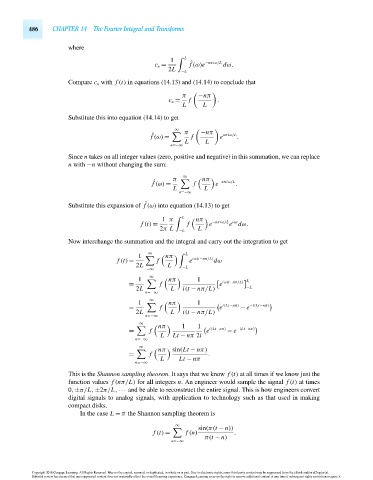Page 506 - Advanced engineering mathematics
P. 506
486 CHAPTER 14 The Fourier Integral and Transforms
where
1 L
ˆ
c n = f (ω)e −nπiω/L dω.
2L −L
Compare c n with f (t) in equations (14.13) and (14.14) to conclude that
π −nπ
c n = f .
L L
Substitute this into equation (14.14) to get
∞
π −nπ nπiω/L
ˆ
f (ω) = f e .
L L
n=−∞
Since n takes on all integer values (zero, positive and negative) in this summation, we can replace
n with −n without changing the sum:
∞
π nπ
ˆ
f (ω) = f e −nπiω/L .
L L
n=−∞
ˆ
Substitute this expansion of f (ω) into equation (14.13) to get
1 π L nπ
e dω.
f (t) = f e −nπiω/L iωt
2π L −L L
Now interchange the summation and the integral and carry out the integration to get
∞ L
1 nπ
f (t) = f e iω(t−nπ/L) dω
2L L −L
−∞
∞
1 nπ 1 L
= f e iω(t−nπ/L)
2L L i(t − nπ/L) −L
n=−∞
∞
1 nπ 1
= f e i(Lt−nπ) − e −i(Lt−nπ)
2L L i(t − nπ/L)
n=−∞
∞
nπ 1 1
= f e i(Lt−nπ) − e −(Lt−nπ)
L Lt − nπ 2i
n=−∞
∞
nπ sin(Lt − nπ)
= f .
L Lt − nπ
n=−∞
This is the Shannon sampling theorem. It says that we know f (t) at all times if we know just the
function values f (nπ/L) for all integers n. An engineer would sample the signal f (t) at times
0,±π/L,±2π/L,··· and be able to reconstruct the entire signal. This is how engineers convert
digital signals to analog signals, with application to technology such as that used in making
compact disks.
In the case L = π the Shannon sampling theorem is
∞
sin(π(t − n))
f (t) = f (n) .
π(t − n)
n=−∞
Copyright 2010 Cengage Learning. All Rights Reserved. May not be copied, scanned, or duplicated, in whole or in part. Due to electronic rights, some third party content may be suppressed from the eBook and/or eChapter(s).
Editorial review has deemed that any suppressed content does not materially affect the overall learning experience. Cengage Learning reserves the right to remove additional content at any time if subsequent rights restrictions require it.
October 14, 2010 16:43 THM/NEIL Page-486 27410_14_ch14_p465-504

